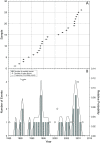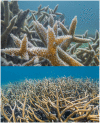Coral Gardens Reef, Belize: An Acropora spp. refugium under threat in a warming world
- PMID: 36753468
- PMCID: PMC9907857
- DOI: 10.1371/journal.pone.0280852
Coral Gardens Reef, Belize: An Acropora spp. refugium under threat in a warming world
Abstract
Live coral cover has declined precipitously on Caribbean reefs in recent decades. Acropora cervicornis coral has been particularly decimated, and few Western Atlantic Acropora spp. refugia remain. Coral Gardens, Belize, was identified in 2020 as a long-term refugium for this species. This study assesses changes in live A. cervicornis coral abundance over time at Coral Gardens to monitor the stability of A. cervicornis corals, and to explore potential threats to this important refugium. Live coral cover was documented annually from 2012-2019 along five permanent transects. In situ sea-surface temperature data were collected at Coral Gardens throughout the study period and compared with calibrated satellite data to calculate Maximum Monthly Mean (MMM) temperatures and Degree Heating Weeks (DHW). Data on bathymetry, sediment, substrate, herbivore abundance, and macroalgal abundance were collected in 2014 and 2019 to assess potential threats to Coral Gardens. Live coral cover declined at all five transect sites over the study period. The greatest loss of live coral occurred between 2016 and 2017, coincident with the earliest and highest maximum average temperatures recorded at the study site, and the passage of a hurricane in 2016. Structural storm damage was not observed at Coral Gardens, though live coral cover declined after the passage of the storm. Uranium-thorium (230Th) dating of 26 dead in situ fragments of A. cervicornis collected in 2015 from Coral Gardens revealed no correlation between coral mortality and tropical storms and hurricanes in the recent past. Our data suggest that several other common drivers for coral decline (i.e. herbivory, predation, sedimentation, pH) may likely be ruled out for Coral Gardens. At the end of the study period, Coral Gardens satisfied most criteria for refugium status. However, the early onset, higher mean, and longer duration of above-average temperatures, as well as intermittent temperature anomalies likely played a critical role in the stability of this refugium. We suggest that temperature stress in 2016 and perhaps 2015 may have increased coral tissue vulnerability at Coral Gardens to a passing hurricane, threatening the status of this unique refugium.
Copyright: © 2023 Greer et al. This is an open access article distributed under the terms of the Creative Commons Attribution License, which permits unrestricted use, distribution, and reproduction in any medium, provided the original author and source are credited.
Conflict of interest statement
The authors have declared that no competing interests exist.
Figures







References
-
- Jackson JBC. Pleistocene Perspectives on Coral Reef Community Structure. Am Zool. 1992; 32(6):719–31.
-
- National Marine Fisheries Service (NMFS). Recovery Plan for Elkhorn (Acropora palmata) and Staghorn (A. cervicornis) Corals. Prepared by the Acropora Recovery Team for the National Marine Fisheries Service, Silver Spring, Maryland. 2015, 167 p.
-
- Shinn EA. Coral growth-rate: An environmental indicator. Journal of Paleontology. 1966; 40:233–240.
-
- Gladfelter EH, Monahan RK, Gladfelter WB. Growth rates of five reef-building corals in the northeastern Caribbean. Bulletin of Marine Science. 1978; 28(4): 728–734.
Publication types
MeSH terms
LinkOut - more resources
Full Text Sources
Miscellaneous

